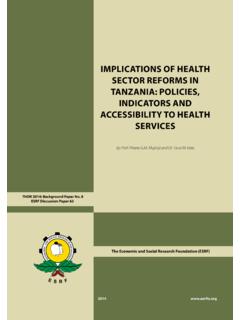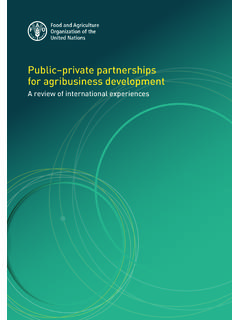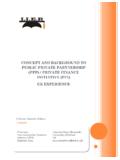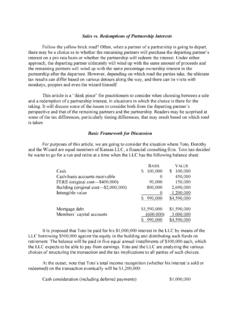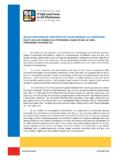Transcription of NO. 2/2016 ESRF POLICY BRIEF
1 ECONOMIC AND SOCIAL RESEARCH FOUNDATION By Dr. Kenneth M. K. Bengesi - Sokoine University of Agriculture, Dr. Patricia Mwesiga - The Mwalimu Nyerere Memorial Academy, and Mr. Tumaini Mrema The Prime Minister s Office (URT) NO. 2/2016 ESRF POLICY BRIEF Public Private Partnership in Tanzania s Transportation Infrastructure: the way PPP is Understood, Challenges and the Way Forward A review of the problem Tanzania s Vision 2025 is based on the overall objec-tive of becoming a middle-income country with per capita income growing from the current US$270 to US$ 2,700 by year 2025. As such, the government has targeted infrastructure development by at least 12% per annum between 2006 and 2015 to support agriculture-led economic growth. Alas, the govern-ment has not been able to sufficiently fund the de-velopment of its transportation infrastructure since the 2010/11 financial year.
2 This has limited the effi-ciency of the country s transportation network in supporting economic growth. The nation s transpor-tation network is comprised of roads, air, railways, pipelines, and water networks. The road network is 86,472 km, of which 12,786 km are classified as trunk road covering 5,130 km of paved and 7,656 km of unpaved roads; and the regional roads cover a total of 21,105 km, out of which 840 km are paved and 20,265 km are unpaved; and the remaining 52,581 km constitute of district, urban and feeder roads. The railway network consists of a 3,682 km track. There are 28 airports, with the Julius Nyerere International Airport being the largest and busiest, and 9 ports under the Tanzania Ports Authority. PPP funding mechanism has been identified as a crucial tool to complement government resources for revitalizing the overstretched and dilapidated EXECUTIVE SUMMARY Meeting the required budget for robust transportation infrastructure sufficient to trigger an agriculture-led economic growth is a national challenge that calls for Public Private Partnerships (PPP) to complement government funding.
3 The national trans-portation network is inefficient and this hampers agricultural growth, limits employment of about 75% rural citizens, and un-dermines Tanzania s geographical potential as a regional trade gateway and logistical hub. Government efforts to create an ena-bling environment - especially the PPP POLICY , legal framework and associated institutions - have not succeeded to attract full participation of the private sector in the development of transportation infrastructure. A 2014/2015 study by ESRF assessed understanding of the PPP concept between the partners and factors associated with the low participation of the private sector actors. Findings depicted some good practices by the government, such as continued review of the institutional framework to accommo-date stakeholders constructive opinions and interests as well as the persistent awareness creation on the PPP concept and framework to stakeholders.
4 The findings also identified areas of improvement for both partners including uncommon under-standing of the PPP concept, unawareness of prospects by private actors, insufficient capital market, lack of sufficient capacity by local private actors, lack of transparency along the PPP procurement chain, lack of negotiations and project monitoring skills among the relevant public officials, and double-dealing among some public officials responsible for PPP processes. The findings call for a concerted amendment of the institutional framework to enhance a common understanding of the PPP concept, create sufficient awareness of PPP prospects among the private actors, raise capital market, capacitate local private actors, and ensure transparent PPP procurement procedures while reinforcing adherence to the public code of conduct among public officials as well as building their negotiation and project management skills.
5 ESRF POLICY BRIEF Page 2 transport infrastructure. Hence, the government es-tablished the PPP POLICY and legal framework to guide delivery of public goods in support of PPPs. These include the PPP POLICY (2009), Act (2010), Regulations (2011), and later on the revised PPP Act (2014) and Regulations (2015). The framework is geared towards provision of contracting authorities with a procedural framework and analytical tools to appraise value for money. Scholars define PPP subjectively in four distinctive ways: (1) as a tool for governance or management, (2) as a tool for development process, (3) as a tool for pro-poor growth, and (4) as a tool for financial arrange-ments. Tanzania s PPP POLICY defines the concept of PPP as an arrangement between the public and pri-vate sector entities in which the private entity reno-vates, constructs, operates, maintains, and/or man-ages a facility in whole or in part, based on specified output specifications while assuming the associated risks for a significant period of time and in return, receives benefits and financial remuneration accord-ing to agreed terms.
6 Private sector participation in PPP, particularly in projects related to transportation infrastructure, still remains low despite the government s efforts in cre-ating a conducive operative environment. This ques-tions the quality or adequacy of the enabling POLICY , legal and institutional mechanisms; harmony in the understanding of the PPP concept between the two parties; and possibility of existence of partnership hindrances in the sub-sector. Answers to these ques-tions were vital in forming recommendations for ap-propriate POLICY options. With the concern to provide the answers, ESRF conducted a study to assess the way PPP is understood by actors and the factors in-fluencing the development of PPP in Tanzania s transportation infrastructure. Findings reveal that: The government is continuously reviewing the insti-tutional framework of PPP to accommodate the con-cerns of its partners, resulting to amendment of Acts and Regulations.
7 For example, to address bureauc-racy, the amended PPP Act and Regulations have set a time frame for making decision on the sub-mitted proposals ranging from 15 to 30 days. The Ministry of Finance and Planning has created awareness and built capacity on PPP POLICY and legal frameworks to 200 stakeholders engaged in banking and POLICY making professions. The understanding of the PPP concept among the two partners is not common. Private sector actors typically lack a comprehensive definition of the concept, which is stipulated by the POLICY . Private sector actors seem to be unaware of the existence of some of PPP opportunities, such as options for unsolicited projects in the transporta-tion infrastructure, and uninformed of existing prospects. Tanzania s capital market is underdeveloped and does not give much support to the private sector to invest in transportation infrastructure.
8 The government has also been slow in decision making towards potential PPP projects. This is possibly attributed to by the lack of a suitable mechanism to transfer calculated risks to the pri-vate sector. Some government officials lack proper negotia-tion and project monitoring skills to close mean-ingful business deals with the private sector, hence leading to either delays or low quality de-liverables. There is corruption among some public officials as observed in the instigation of suspicious con-tracts and cost inflation in the procurement proc-ess. The private sector doubts the loyalty of the gov-ernment in keeping up with its commitments and obligations as stipulated in PPP contracts. The private sector is concerned with red tape and lack of transparency in the procurement proc-ess related to PPP projects.
9 Development funds, especially in transportation sec-tor. However, it was evident that there is a room for improvement among both actors. Some of the areas of improvement include: government creating awareness of the concept of PPP to a wider commu-nity of the private sector, joint ownership of contrac-tual agreements, and timeliness in decision making. Others are capital market development and assur-ance of reliable data for project appraisal. Conse-quently, the private sector should deliberately seek prospects and consider investing in long-term high risk projects with the goodwill of contributing to development. POLICY recommendations The study proposes the following particular actions specific to each PPP actor for improving participa-tion in PPP projects in Tanzania, including develop-ment of the transportation infrastructure: The government should keep up the ongoing re-view of the institutional framework to accommodate the views of stakeholders.
10 This encourages partici-pation of the private sector. The government should tirelessly educate the stakeholders on the PPP concept, increase aware-ness creation programmes to private sector on the existing and potential PPP projects. The private sector should commit itself to creating common understanding of the concept of PPP as stipulated by the national PPP POLICY and should deliberately search for available PPP prospects. There should be a thorough, inclusive, comprehen-sive and transparent procedure for procurement of PPP projects in transportation infrastructure. Though the timing for decision making within the reviewed procedures seems proper, it is still early to comment on the practical experiences of its imple-mentation. However, transparent efforts are needed on fast tracking decision making processes in all PPP procurement arrangements.



